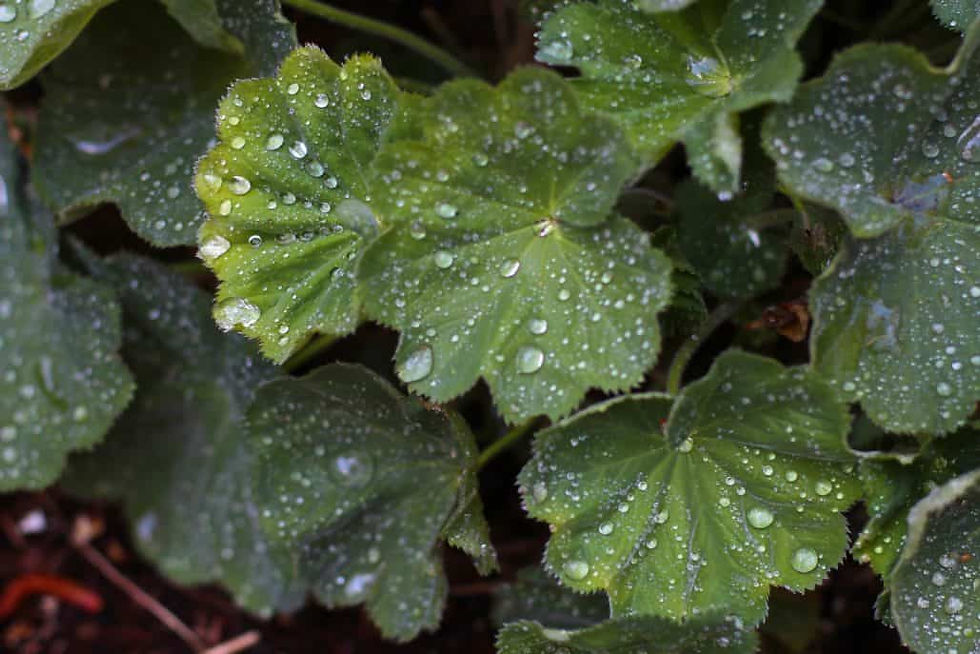Lady’s Mantle
- May 30, 2023
- 3 min read
The Universes Gift to Us

AKA: Alchemilla vulgaris; LE family: Rosaceae - Lion’s foot, bear’s foot, nine hooks, Leontopodium, stellaria.
Propagation/Description: Lady’s mantle thrives in shady settings with moist soils and can tolerate some sun or dry conditions. It grows in clumps, first near to the ground; as the plant flowers, it reaches 1-2 feet in height. The leaves are distinctive and semicircular shaped, scalloped, toothed, and creased like a lady’s fan. They are covered in soft downy hairs with small yellowish green flowers that grow in clusters above the leaves. It self-seeds and as such is considered evasive by some. It adapts to both shady and sunny areas and is known to be drought tolerant once it has been well established. Although it does prefer afternoon shade in hotter climates. It is easier to propagate from established clusters by digging up and dividing the root ball found or transplanting the commonly found volunteer babies that will pop up due to the self-seeding nature.

Folklore/History: It is native to Europe. Andres de Laguna translated Dioscorides’ Materia medica in 1570 and recommended two ways to prepare and use this beautiful herb. He used a root powder mixed with red wine for both internal and external wounds. He also used a decoction or tincture of the aerial parts for broken and fractured bones in children. Originally it was revered as an herb of Freya, this herb was used in fertility magic and for protection. Lady's Mantle was also associated with Fairy lore - it was said that the Fairies too appreciate the sacred dew, which they collect and drink as a magical elixir. Because it pumps excess water up from its shoots, where it then bubbles on the edge of the leaves antient Alchemists believed that they needed this powerful “moon water” to produce the philosopher’s stone.
Medicinal: Traditionally it was used for wounds both internally and externally. It was believed to help stop bleeding, slow excessive menstruation, used as an astringent, and universally thought of as a universal cure. In today’s holistic medicine it is still prized as a wound healer and the astringency has proven to help in stanching bleeding aiding in the healing of the wound to begin earlier. It has also been thought to help with menstruation but has a progestogenic action. This means it helps relieve heavy bleeding, cramps, and regulation. Studies have shown that it also helps with postpartum care, fibroids, endometriosis, canker sores, menopause support and to act as a liver decongestant. Its astringent properties make it helpful to treat diarrhea and gastroenteritis.

Spiritual: While our ancestors believed useful for fertility, transmutative and protective magic, it is now more notably known to represent magic itself to some as it is linked to feminine and gentle, creative magic. It has also been associated with Love. Whether used to assist with fertility, passion, a love interest, magnify the power of any working or any other type of creativity, the magic in Lady’s Mantle has been an ever-faithful aid in the craft.
Summary: Lady’s Mantle is a fairly new plant for me, and the implications of its uses are innumerable. As a woman who is facing menopause, I am fascinated by the prospect of what this gorgeous plant can do for myself. I also am in love with the fact that it is useful in so many other ways. While I hope you enjoy this little glimpse into this divinely feminine plant, I will continue to do more research into it to find out all the magic it possesses!
Bibliography:
Hedge Witch’s Field Guide by Siolo Thompson; pages 107-110.
Encyclopedia of Magical herbs by Scott Cunningham, Expanded & Revised Edition; Page 151.
Encyclopedia of Herbal Medicine, 500 Herbs and Remedies for Common Ailments by Andrew Chevallier,
FNIMH; Pages 163-164






Comments